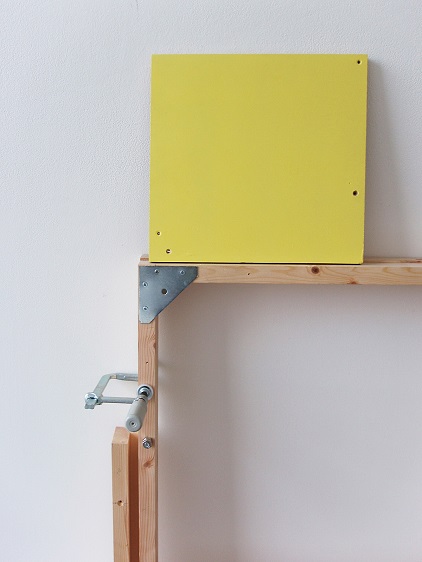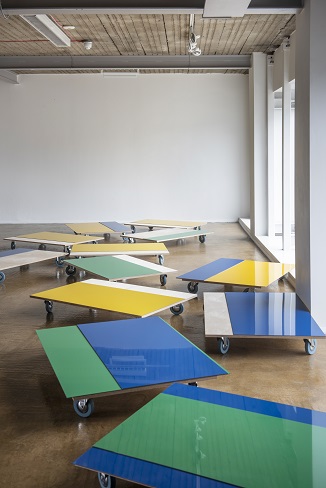The curatorial and editorial project for systems, non-objective and reductive artists
working in the UK
Alan Hathaway | No Dark Things
Platform A Gallery, Middlesbrough, 22 November 2018 – 8 January 2019
A review by Annie O’Donnell
©Copyright Patrick Morrissey and Clive Hancock All rights reserved.
‘We have no dark things/Nothing to hide or that/Just some heads and a wish/Something
to scream about’ Echo & The Bunnymen (1981)
Through a non-hierarchical process of trial and experimentation, ‘No Dark Things’
skilfully avoids a linear narrative flow around pictorial codes such as scale, colour,
manipulation of materials, and indeed means of display in abstraction. Instead, in
this, his first solo show at Platform A, Alan Hathaway creates an exhibition where
titles and structures work together, building hybrid, rhizomatic relationships between
components from daily life, the exhibition space and the surrounding architecture
and street furniture of Middlesbrough Railway Station. Hathaway tests each one against
the other, weighing them for directness and ambiguity, and emphasises research practices
based on making and play. ‘No Dark Things’ resists the idea of complete closure or
‘fetish finish’, and its initial iteration in November was physically extended and
ruptured over the exhibition run, until the finissage ’The Remix’ in January.
The work is new, made within the last three months, and the construction is fully
revealed, both in the wooden supports and aluminium composite panels of the larger
works, and in the discovered or mixed colours of a series of smaller ‘combinations
of found or discarded industrial materials that are modified, rescued and recycled’.
The economy of means, and apparent simplicity in the repetitions of geometric forms
is deceptive however, as more elusive dialogues about the temporary, and the fragmentary
occur, touching on utopian concepts of art as a means to confront social and political
challenges, and developing Hathaway’s long-term examination of painting as shelter.
This all happens through restraint, not bravado, and transformations, tensions, and
contradictions are worked through both in place and out of place, ‘falling in-between’
past, present and future imaginings.
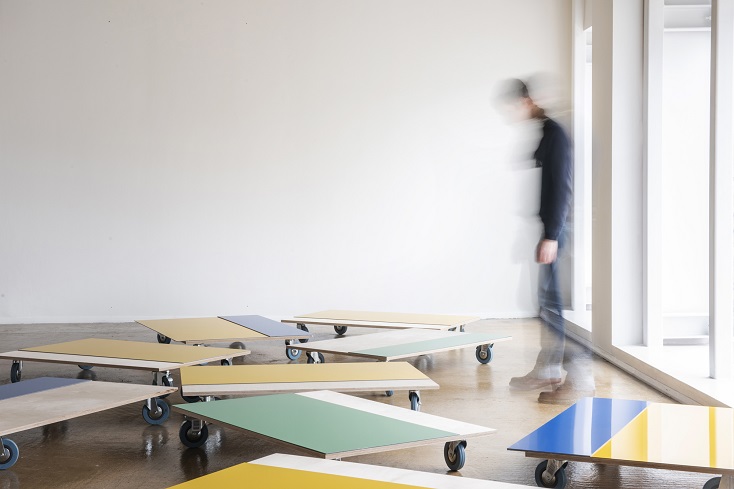
No Dark Things (remix) Installation view. photo Jason Hynes, courtesy the artist
and Platform A Gallery
The walls and the floor of the gallery are inhabited by ‘flatpack’ works, forming
vertical and work-surface picture planes, turning the interstices between the works
themselves, and between the works and the walls, into spaces of equal importance.
The walls and floor also appear to be almost interchangeable to Hathaway. The elements
that hang or lean vertically, resemble stud partitions or screens rather than frames,
and the horizontal works are like worksite trolleys or half-completed childhood go-carts
(known locally as bogeys). This juxtaposition creates a sense of ‘which way is up?’,
where the colourful billboards in the vicinity with promises of things to come, and
the ongoing building work in the station, join with the exhibition to create a future
nostalgia, a yearning for something that is yet to happen or may never happen.
Hathaway uses several approaches to conjoin title and image in his practice. Those
applied to works in ‘No Dark Things’ introduce multiple associations and act as alienating
devices. One is common in the Modernist canon, ‘Untitled’ followed by a colour description.
The second references song lyrics, here ranging from artists such as The Smiths to
Primal Scream, with words that examine everyday life lived out in (extra)ordinary
circumstances.
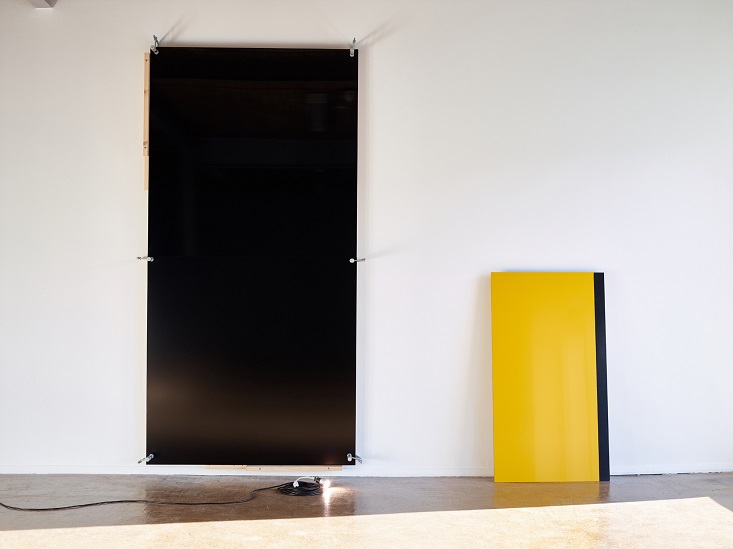
Shoot Speed, Kill Light and Untitled (GLOSS yellowBlack) Photo Ant Chambers, courtesy
the artist and Platform A Gallery
Shoot Speed, Kill Light, 2018 (aluminium composite, wood, f-clamps, electrical wire,
LED bulb, electrical fittings), is a work that dominates the far wall of the gallery
space. The black flex of a single light snakes its way across the floor to illuminate
the lower section of the tall black rectangle, as if work is still being carried
out on it. Its reflection glows dully in the matt darkness. The opaque protective
film covering the aluminium of the work has been partially peeled back, only revealing
the material’s gloss surface at the top. The viewer therefore sees herself as incomplete,
only visible in this higher section - like a drawing in a game of Exquisite Corpses,
or like a woman sawn in half, or vanishing in a stage act’s Disappearing Box. The
handles of the six clamps that hold the construction together suggest a potential
for turning, to tighten or loosen the connections between materials. Attachments
can be strong, yet temporary.
The discovery that the yellow of the salt bin and the black bollards in the station
carpark outside the window are repeated directly in the nearby Untitled (GLOSS yellow/black),
2018 (aluminium composite, protective film, wood) is a reminder of the power found
in the proximity of things, breaking and shifting the viewer’s understanding of the
tensions between art as life/life as art. The yellow rectangle outside is in landscape,
rather than portrait orientation, and the bollards repeat the black stripe running
down the right hand edge of the work’s yellow section. Across the gallery, a flatbed
trolley again throws back a yellow repetition.
The N.W.R.A. Photo Ant Chambers, courtesy the artist and Platform A Gallery
‘The North will rise again/Not in 10,000 years’ The N.W.R.A. The Fall (1980)
Looking through the gallery’s glass doors into the entrance space, a visitor might
believe the installation is still underway, as while Hathaway considered and rejected
showing the resulting debris from the exhibition, the position of the work The N.W.R.A.,
2018 (acrylic paint, MDF, wood, f-clamps, metal brackets) is ‘casual formal’. It
is leaning against the wall, and its collage of elements – the metal brackets at
the joints, the empty spaces where colour might be expected to be, and the repeated
clamps along the nearside, propose that this is in the process of being made – made
by someone thinking performatively and reflexively, perhaps pausing before remaking,
again and again. Hathaway’s use of the Modernist grid as both ‘escapist structure
and ideological device’ is strongly stated here. The N.W.R.A. has a square yellow
section balanced, as if ready for flight, at the top left edge of a larger wooden
frame with cross braces. The colour also fuses into a line from the Fall song, directly
relevant to the industrial past of Middlesbrough, home of Platform A: ‘The West German
government brought over large yellow trains on Teesside docks’. The current port
is now a rare example of commercial success in uncertain times.
Of the smaller wall hung works, Untitled (MATT white), 2018 (aluminium composite,
plywood) is particularly intriguing. The aluminium panel is divided in half vertically,
and a small groove in this split suggests it could be, or had been, forcibly prised
open. It is a quiet work, yet full of disquiet. Viewed frontally, the work’s material
and colour is reminiscent of a domestic cupboard or medicine cabinet, from the side,
it re-forms itself into a painting. Meanwhile on the gallery’s floor, Untitled (GLOSS
green/yellow/blue), 2018 (aluminium composite, birch ply and castors), waits - three
trolleys that cluster around a wall support like horses outside a saloon. They share
the properties of the wall based works but flatness is further emphasised, as they
lie so close to the concrete, re-forming the perimeters of the picture plane, and
bonding them with memories of the wheeled suitcases of the travellers on the station.
They are not monochromes like David Batchelor’s trolleys, but their aluminium surfaces
do seem to make colour independent, unleashing potential to send it skimming across
the floor. They are playful, sharing that characteristic with the practice of Robert
Rauschenberg during his long touring collaboration with Cage and Cunningham, when
transportability was built into his work’s theatrical impact.
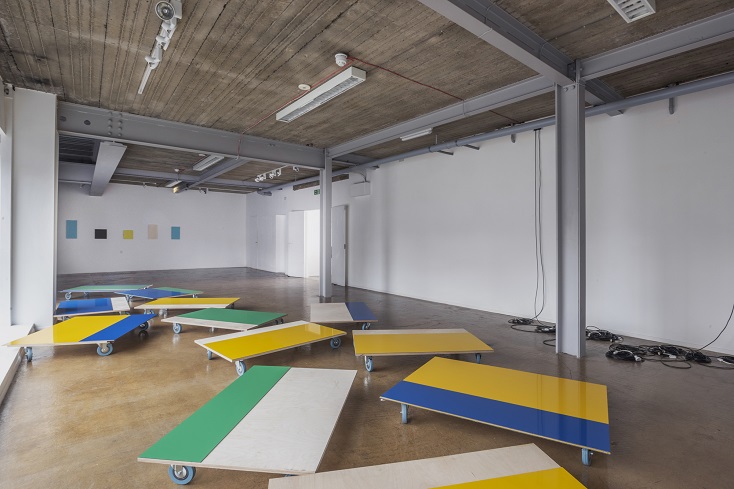
No Dark Things (remix) Installation View photo Jason Hynes, courtesy the artist and
Platform A Gallery
‘The Remix’
‘This is not a composition. It is a place where things are, as on a table or on a
town seen from the air: any one of them could be removed and another come into its
place through circumstances analogous to birth and death, travel, housecleaning,
or cluttering.’ John Cage ‘On Rauschenberg, Artist, and his Work’ (1961)
The prospect of ‘No Dark Things’ morphing into something completely different by
the end of the run was a tantalising one. Re-encounters with works in different places
in the gallery brought unexpected pleasures and posed unexpected questions. Is that
work the same as it was earlier or not? Was that colour there or there? Elements
were totally reorganised by dismantling and reassembling: they were contracted or
expanded, scaled up, or remained as they were. The walls became largely deserted
apart from the repeated panels of You are sleeping. You do not want to believe. which
became re-energized, and the large aluminium rectangle of Shoot Speed, Kill Light
actually did vanish, together with the memory of a disappearing woman. The nearby
strings of lights from Untitled (MATT green/GLOSS blue) remained. Were they fewer
in number? The yellow square of The N.W.R.A. did fly off, more wooden supports arrived,
then Untitled (GLOSS yellow and black) appeared in its place, leaving its colour
counterparts in the carpark. The three flatbed trolleys of Untitled (GLOSS green/yellow/blue)
multiplied until they almost filled the gallery floor, a team of hard-edge paintings,
each carrying reiterations of bright colour in horizontal planes.
‘No Dark Things’ and ‘The Remix’ could be experienced as independent exhibitions
within a single location, and it was not essential to view both, in order to take
away a desire to re-examine the transitory nature of daily life. However, Hathaway
speaks an authentic artistic language of disturbances and interruptions that is best
experienced in this time-based format, where new beginnings are threatened, promised
and carried out. These tactics for change will continue as the structures move to
future sites.
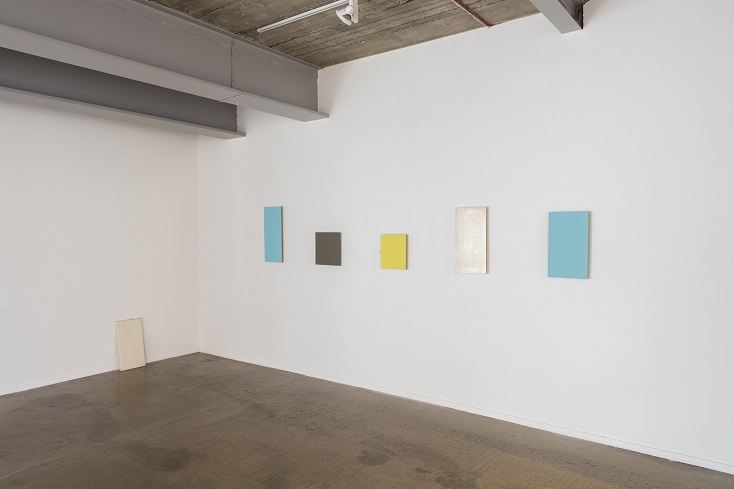
You are sleeping, you do not want to believe. Installation view, photo Jason Hynes,
courtesy the artist and Platform A Gallery
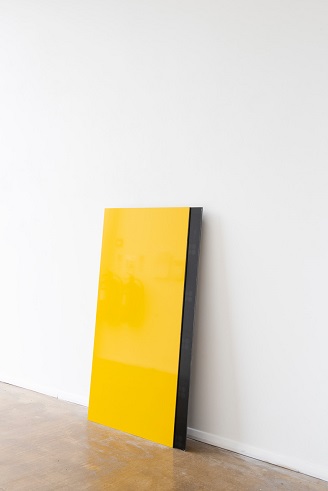
Untitled (GLOSS yellowBlack). Photo Jason Hynes, courtesy the artist and Platform
A Gallery
No Dark Things (remix) Installation view. Photo Jason Hynes, courtesy the artist
and Platform A Gallery
